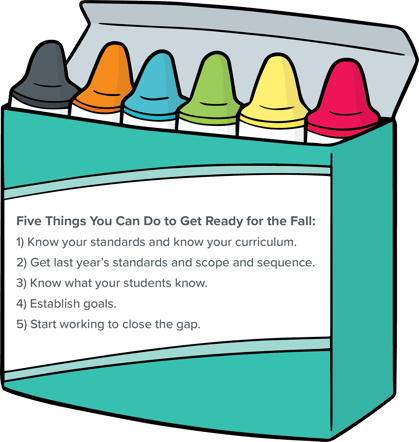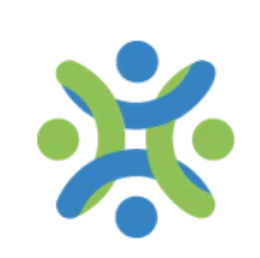
There is something about the smell of a new box of crayons that takes me to the start of a new school year every single time. In fact, when I switched from teaching to working with teachers, I would intentionally try to avoid elementary schools at the beginning of the school year otherwise I would be in some poor teacher’s room helping to get the supplies sorted, bulletin boards put up, and crayons distributed to all the desks. New notebooks, new pencils, but especially new crayons.... they have the smell of possibility, of untapped potential...it’s the smell of hope, excitement, and dreams all mixed together. As I reflect on my years in the classroom, I have come to realize that each group of students was like a new box of crayons. Each one was special, and different from the rest. Each one capable of so much. Each one just waiting for me to help them meet their potential.
In a previous post, I talked about the need to review past performance to provide insight into the shape of the classroom for the school year. This data transfer can happen in many ways – transfer of information from a permanent record, use of the Classroom Scorecard, or team meetings to assign students. In a typical year, I would say that these activities would be enough to get started for the following year. But this year is in no way typical, and I don’t think I’m going out on a limb when I say you aren’t going to have enough information when those students arrive back in class. So, let’s talk about some things that you can do to get ready, and some things to do once you have them in class.
1. Know your standards and know your curriculum.
Know what is critical to teach to cover the standards. You probably are saying “But I know my curriculum and my standards!” and you most likely do but look at them again with an eye to what can be more lightly touched and what is an absolute must.
2. Get last year's standards, and if you can, get last year's scope and sequence.
This is vitally important because you are going to want to know what was to be taught in those last 3 months. Study that with an eye towards what is essential for students to be able to perform at your grade level. Start to develop a game plan to review/recover this potentially lost work as part of your ongoing teaching.
3. Know what your students know.
Now that you have potential solutions planned out, you need to know what your students know. I’m going to use the dirty word here – you are going to have to test these kids. (This blog series is called ‘Practical Assessment’ after all). You might ask me “So why plan out solutions before I test the kids?” You need to plan out the solutions so that you can understand what was critical that might have been missed and what wasn’t so that you can choose what to test on and what can wait. Now it is time to find out where to start. Start testing. Get that understanding of what needs to be retaught and what doesn’t. Not sure what test to use? I’ll cover that in the next post in this Practical Assessment series.
4. Establish Goals.
Once you have made it through step three, you are now armed with knowledge about what the students should have learned, what the students are going to be taught, and what the students do know. (If you skipped three, you must go back and do it. Why? Because if you don’t, you are not going to have that baseline to tell you what your students know. Go look in those permanent records for end of year test scores, final grades and projects. Not there, are they? So, you are going to have to do some serious testing at the beginning of the year to get that information.) Using all that you have gathered you will now need to establish goals. These should reflect the results of the tests that you gave to your students, as well as the standards you know are going to be most important. Use whatever objective language you’re most comfortable with as you write down what you want your students to be able to do in a week, in a month, in a year. Don’t forget to include the standards from last year where the students are weak, especially ones that are critical to what is in this year’s curriculum.
5. Start working to close the gap.
You’ve armed yourself with knowledge about the standards, information about your students, and you have set your goals. This is not going to be a walk in the park, though. You need to treat this like ‘The Couch to 5K Training Plan’ and realize that this is going to take some time to do. Look at those goals again. Are they achievable? Do they have a time frame for completion? Are the deadlines spread out? Understand that this gap in learning is not like what we normally experience when students come back after summer break. This past year has created a large gap that will have to be closed, and it will take time. If you are using a test with a vertical scale, you’ll be able to track that progress over the year. I’ve got an upcoming post about that, too.
I want to share a story with you. When I was in college, I took Mathematics for Teachers with people who were getting certified for different ranges of grades. I was there for pre-K through 6th grade. Some others were working towards a middle school certification. Our professor, Dr. Bain, was spending a great deal of time on early numeracy in one class. One of the college students pursuing middle school certification students finally let the frustration that had been building show, raised a hand, and asked “Why do we have to learn about these early grade standards?” Dr. Bain blinked, paused, and then said, “If you don’t know what has come before you will never be able to prepare students for where they will need to go.” This year, more than any other, we need to evaluate what should have been taught, what was taught, and what our students know.
You’ll be getting a new box of crayons soon, but this box will be so very different than any one you’ve ever had before. When you open it, there will still be that smell of possibility, but some of the crayons may not be as sharp as the others. Some may have the wrapper peeled off. Some may even be broken. But even broken crayons can produce the most amazing work.
And it will be because you saw their potential and helped them to reach it.





